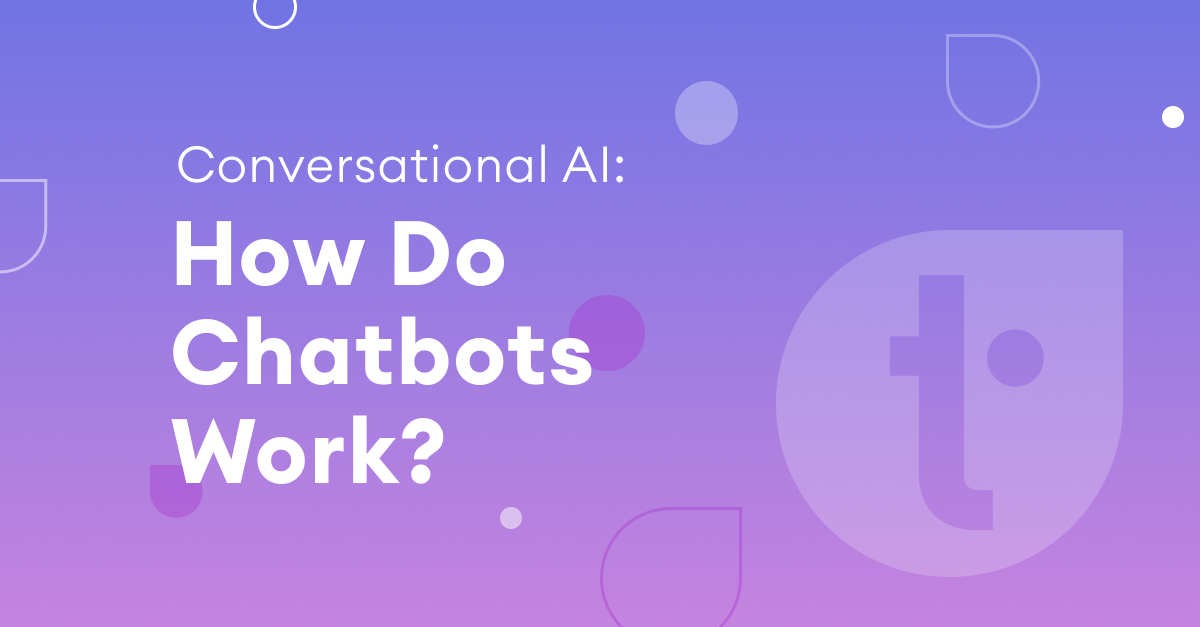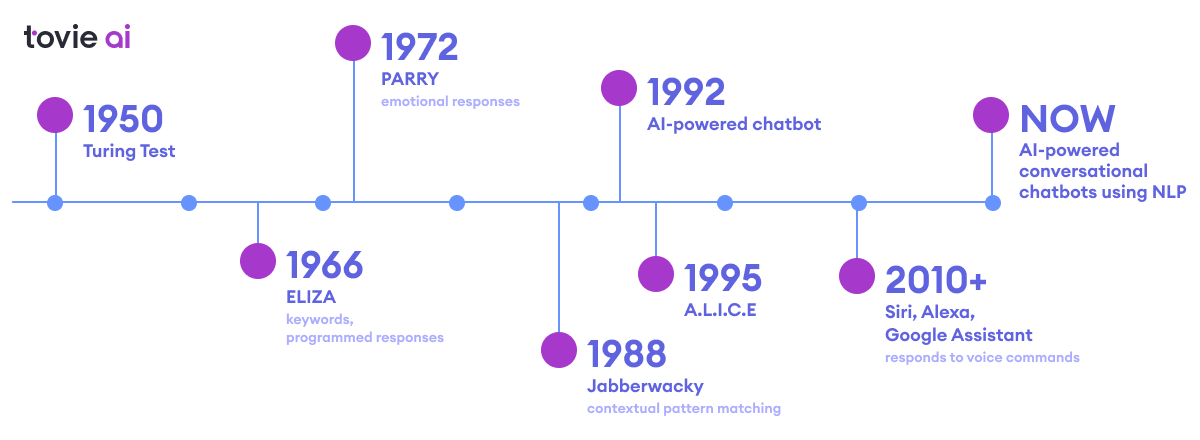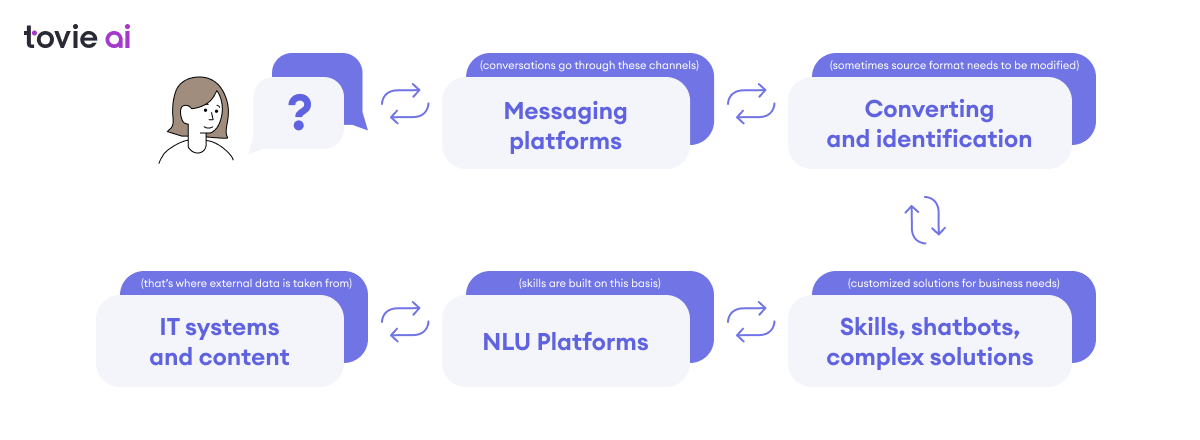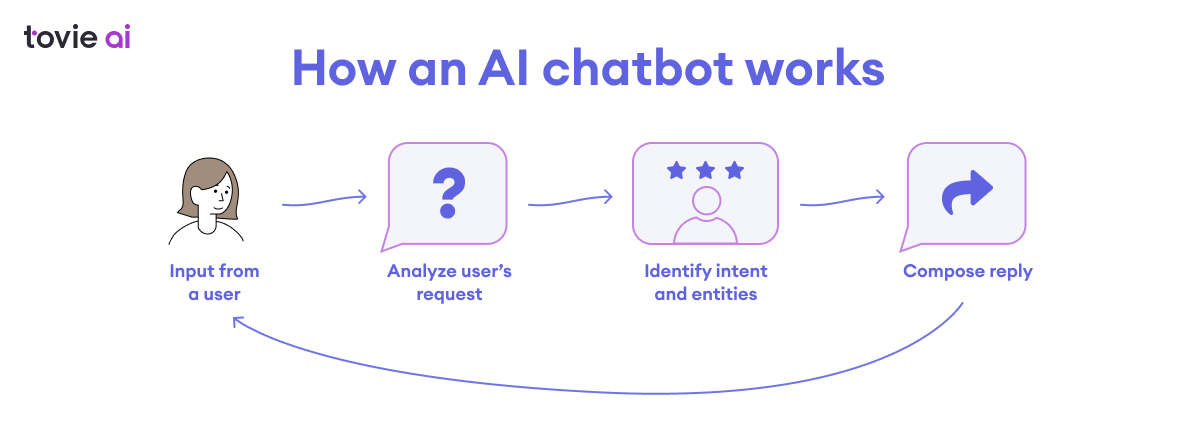How Do Chatbots Work? A Brief Introduction with Tovie AI
April 28, 2022
6 min read

Chatbots now surround users on all online channels, whether it’s an Instagram DM chat, Facebook Messenger, or a company website.
Chatbots are one of the most common and promising tools for businesses in the coming years. A bot is a program that automatically performs an action based on specific intents and algorithms. Customers can communicate with bots using a chat interface or voice, just as they would with a human.
The COVID-19 pandemic has accelerated the pace of chatbot adoption beyond initial projections. The global market for chatbots is expected to grow from $2.9 billion in 2020 to $10.5 billion by 2026. It is expected to grow at a 23.5% CAGR over the forecast period, from 2020 to 2025.
Timeline of chatbots
For a long time, researchers have been fascinated by the idea of being able to talk to computers and get answers quickly. Even before the term “chatbot”, they began working on machines that interacted with humans through natural language.
ELIZA and A.L.I.C.E
The first chatbots and development systems appeared quite a long time ago. In a nutshell, it all started with Alan Turing in the 50s; the Eliza program in the 60s; linguistics, and machine learning research in the 90s.
ELIZA, the mother of all chatbots, was developed in 1966 at MIT.
It answered some very simple decision tree questions and imitated a conversation using “pattern matching” and substitution techniques, which gave users the illusion of understanding on the part of the bot.
On November 23, 1995, Richard Wallace introduced the A.L.I.C.E. (Artificial Linguistic Internet Computer Entity), also called Alicebot or simply Alice.
It was inspired by Joseph Weizenbaum’s classic ELIZA program. It is one of the strongest programs of its kind, and it won the Loebner Prize for humanoid talking robots three times, in 2000, 2001, and 2004. The program uses an XML Schema called AIML (Artificial Intelligence Markup Language) for specifying the heuristic conversation rules.

The rise of voice assistants
The next big thing in the conversational AI industry was the advent of voice assistants. Siri was launched in 2010 and set the tone for all other virtual assistants that have appeared in this decade.
Then, in 2012, Google launched Google Now.
This assistant was developed based on Google’s “voice search” feature. It stood out because it could remind the user of events, based on information received via email or calendar.
And in 2014, Amazon released Alexa.
Alexa can perform many of the standard functions of a virtual assistant. It can also order items from Amazon and control smart devices, making it a home automation system.
Nowadays
These days, the situation in this area has changed noticeably. Due to the development of algorithms that detect semantic similarity and machine learning solutions. This, in turn, has made approaches to text categorisation and NLU model training fast and convenient.
Natural language understanding (NLU) and natural language generation (NLG) are the most promising among them, and these areas have the highest growth rates.
Mordor Intelligence: The global NLP market was valued at $10.72 billion in 2020 and is expected to be worth $48.46 billion by 2026, registering a CAGR of 26.84% over the forecast period (2021-2026).

How does a chatbot work?
Chatbots today live on platforms such as Facebook Messenger, WhatsApp, Instagram DMs, Slack, WeChat, or even a website. Like regular apps, chatbots have an application layer, a database, an API, and a conversational user interface.
There are currently three core types of chatbots
- Rule-based chatbots
- Intellectually independent chatbots
- AI-powered Chatbots
Rule-based chatbots
A rules-based chatbot uses a tree-like flow to help guests with their queries. Such chatbots guide users through scripted questions to eventually help them find the right answer. The conversation in this case is controlled by a ready-made database of frequently asked questions.
The whole methodology is called the “rules-based approach”. It is based on finding conventionally meaningful particles of phrases, encoding those phrases, and creating a scripting language to create scripted conversations
The latest development mechanisms are complex systems that include
- NLU part that contains intent recognition and named entity recognition.
- Linguistic modules
- Dialogue management modules
- Integrations and external APIs
We have to admit, a great deal of conversational solutions based on that system is quite labour-intensive. You’ve got to put a lot of effort into a chatbot to make it communicate on a broad range of topics or to cover a specific discipline with profound knowledge.
Intellectually independent chatbots
Intellectually independent chatbots use machine learning (ML), which helps them learn from data and user queries. This then helps chatbots recognise certain patterns and make decisions with minimal human involvement.
AI chatbots
Instead of relying on a predetermined human-designed result, chatbots with artificial intelligence first understand what a question is about.
Let’s see how a user-chatbot interaction pattern may be presented

- A user sends their query into one of the accessible channels, such as speakers, phones, smartwatches, etc. Behind each query lies intent — the user’s wish to get the correct answer or to get the service, product, or some content like music or video.
- There may be further processing or conversion of the message format. Dialog platforms use text recognition techniques, while some channels may only consider voice. A conversational dialog system consists of an automatic speech recognizer (ASR), a text-to-speech synthesizer (TTS), and integration systems.
- The query, converted into text, is then passed to the dialog platform. The goal of the platform is to capture the basic semantics of a given word sequence, retrieve the intent, process it correctly, and give the correct answer or action. Examples of such external systems can be any CRM system, contacts databases, or services like Deezer or Google Play Music.
- After receiving the data, the dialog platform generates a response – a text, a voice message (using TTS). Then it triggers content streaming or notifies about the performed action (e.g. adding a purchase to cart).

Therefore, AI chatbots are not suitable for everyone because they require a training period and tend to require more effort to get started. However, once the training period is over, AI bot can become incredibly powerful.
All these bots can be easily build with Tovie DialogStudio
Sign up for Tovie AI newsletter
Get the latest posts and fresh analytics delivered straight to your inbox



